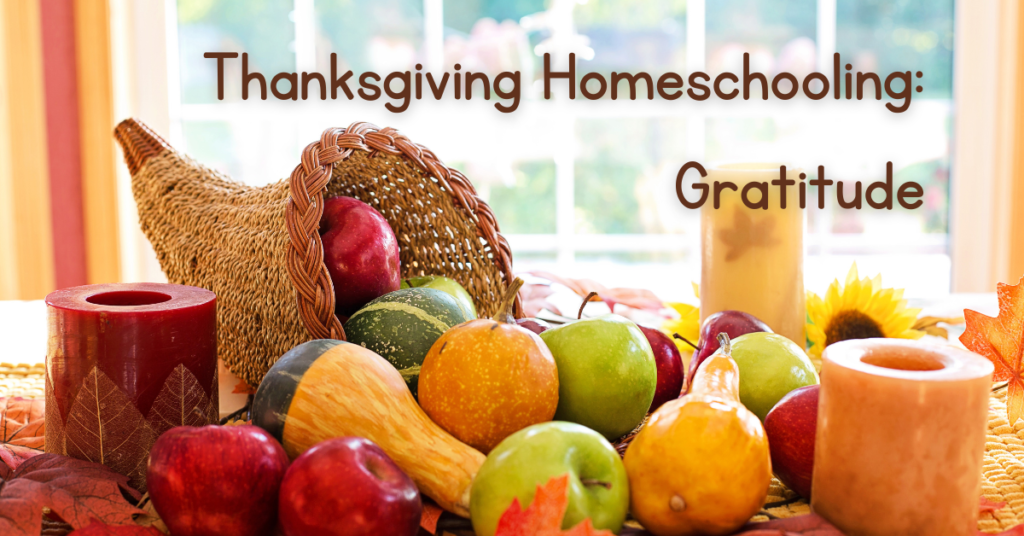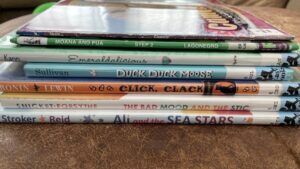Although there are some parts of Halloween that are worthwhile, I find that there is too much focusing on scaring and scary things for my taste. Although K loves the idea of Halloween from seeing it on shows, she hasn’t tried to do anything or asked to decorate early, so we haven’t had to focus on it. She was happy with some Halloween coloring and painting pages, but she’s really enjoying her regular curriculum so I was happy to skip bringing any additional Halloween ideas into our homeschool. The only thing I really like about Halloween is the cute and adorable kids in costumes, though maybe in the future we’ll do a unit study on Halloween and All Saints Day so it’s not focused on the creepy or the scary.
I feel like Thanksgiving and Christmas lend themselves so much better to homeschooling. There are a plethora of facets of these holidays that can be studied or discussed. There are so many topics that can be focused on depending on your child’s interests or learning styles.
I’m Only Here for The Food

We do a lot of hands-on learning and life-schooling in our homeschool. If we were just to focus on the food aspect of Thanksgiving, we could have home ec (baking and cooking), math (determining how much food is needed for the guest load and multiplying or dividing ingredients to accommodate), history (how the passing of time has affected what food is served), science (the effect of tryptophan on the body), and physical education (preparing for and participating in a turkey trot).
I’m sure there are even more areas of study that I’m missing, such as Bible studies (perhaps learning about gluttony or a specific feast, or maybe the story of Jesus feeding 5000 people with only 5 loaves of bread and 2 small fish). Or you could choose another focus for Thanksgiving and find just as many areas/school subjects to cover.
What is Gratitude?
One focus for Thanksgiving, which I think is truly the gift that keeps on giving, is gratitude. But what is gratitude? According to Google’s dictionary, gratitude is “the quality of being thankful; readiness to show appreciation for and to return kindness.” When I explain it to my preschooler, I ask her about things that she likes and is happy to have. Just like we’ve taught her to say thank you when someone makes her food, helps her, or gives her a gift, it’s the same idea. What are things, or who are people, that feel like gifts to her? These are the things for which she is grateful.
Have you ever heard the phrase “gratitude is an attitude” or heard you should have “an attitude of gratitude”? The idea is that you are thankful for what you have and what you receive and express your gratitude without expecting anything in return. Saying thank you to someone currently serving in the military or a veteran is a great example of this. You may not know them, but when you see someone in a military uniform, you can be certain that they are ready to sacrifice their time, comfort, and safety, to keep those of us at home safe. When you thank them, it means you’re thinking about their sacrifice and showing your appreciation. You don’t expect them to do more or change their behavior because you thanked them. You’re just grateful that they exist and are willing to do the work.
30 Days of Gratitude
A common theme for November is 30 days of gratitude. I was lucky enough to be reminded of the idea of a 30 days of gratitude challenge on the first of the month, and I’m planning to share my gratitude everyday on my personal Facebook page. Although you don’t need to, I chose to post it publicly so that I can see it every year as a reminder to be grateful for each thing I pick this year.
Another option would be saying a prayer of thanks to God, and/or writing it in a prayer journal. Quoting from Ephesians 5:20 in the Good News Bible, “In the name of our Lord Jesus Christ, always give thanks for everything to God the Father.” God created the world and everything in it. He deserves credit for everything.
Adding Gratitude to Your Homeschool
Participating and tracking your 30 days of gratitude is not just a great activity for moms, it’s a great activity to do in your homeschool. Whether you each share your gratitude daily, create copywork of what you’re each grateful for each day, or create one family gratitude tree or an individual one for each person, there are infinite ways to bring this activity into your homeschool and incorporate multiple subjects (language arts, penmanship, art).
Don’t worry if you missed the start of the month. You can always choose a shorter time frame or roll it over into December to finish out your 30 days. I have friends that have a daily gratitude practice (imagine your kids naming 366 things that they’re grateful for in 2024!!). I think that would actually be a fun activity: each family/homeschool member creates a paper chain of everything they’re grateful for over the course of the year, and then use each of the chains to decorate your home or Christmas tree.
How are You Going to Incorporate Gratitude into Your Homeschool?
I shared a few of my ideas, but what do you think? Are you going to try out anything I shared, or do you have your own ideas for teaching gratitude in your homeschool? I’d love to hear them if you do. They might be great additions for my family in our homeschool.
Thank you for joining us In Our Homeschool.
Disclosure: As an Amazon Associate I earn from qualifying purchases. This post may include affiliate links which means I may earn commissions for purchases made while using my link.





